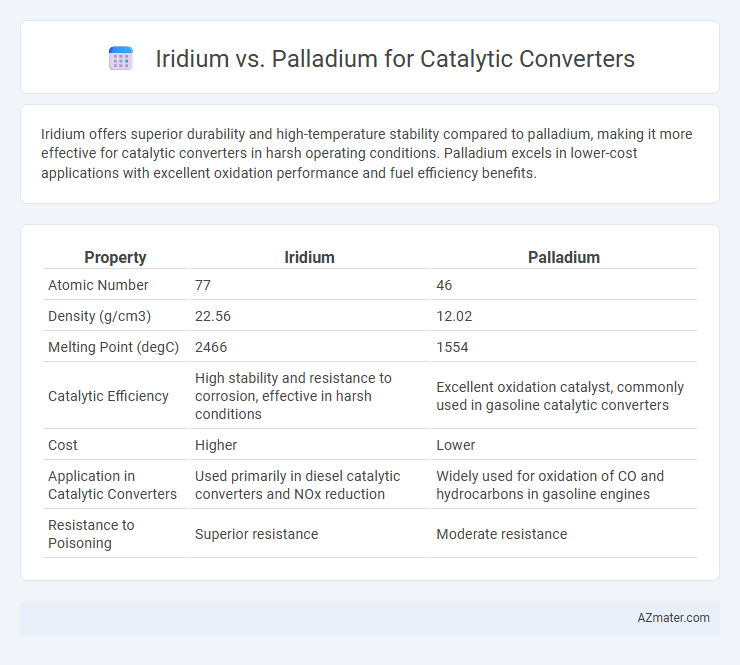Iridium offers superior durability and high-temperature stability compared to palladium, making it more effective for catalytic converters in harsh operating conditions. Palladium excels in lower-cost applications with excellent oxidation performance and fuel efficiency benefits.
Table of Comparison
| Property | Iridium | Palladium |
|---|---|---|
| Atomic Number | 77 | 46 |
| Density (g/cm3) | 22.56 | 12.02 |
| Melting Point (degC) | 2466 | 1554 |
| Catalytic Efficiency | High stability and resistance to corrosion, effective in harsh conditions | Excellent oxidation catalyst, commonly used in gasoline catalytic converters |
| Cost | Higher | Lower |
| Application in Catalytic Converters | Used primarily in diesel catalytic converters and NOx reduction | Widely used for oxidation of CO and hydrocarbons in gasoline engines |
| Resistance to Poisoning | Superior resistance | Moderate resistance |
Introduction to Catalytic Converter Materials
Catalytic converters rely on precious metals like iridium and palladium for efficient exhaust gas treatment, converting harmful pollutants into less harmful emissions. Iridium offers exceptional durability and resistance to high temperatures, while palladium is prized for its superior oxidation catalytic performance and cost-effectiveness. Selecting the appropriate material impacts the converter's lifespan, emission control efficiency, and overall environmental compliance.
Overview of Iridium and Palladium
Iridium and palladium are both critical platinum-group metals extensively used in catalytic converters for reducing harmful emissions in vehicles. Palladium is highly favored due to its excellent oxidation properties, cost-effectiveness, and widespread availability, making it a primary choice in many automotive catalysts. Iridium offers superior thermal stability and resistance to corrosion, enhancing catalyst durability under extreme conditions despite its higher cost and scarcity compared to palladium.
Chemical Properties Relevant to Catalysis
Iridium exhibits exceptional chemical stability and resistance to oxidation, making it highly durable in catalytic converter environments subject to high temperatures and corrosive exhaust gases. Palladium offers superior catalytic activity for oxidizing hydrocarbons and carbon monoxide due to its excellent oxygen adsorption and desorption properties. The choice between iridium and palladium in catalytic converters depends on balancing iridium's robustness with palladium's faster catalytic reaction rates, impacting overall efficiency and longevity.
Catalytic Efficiency Comparison
Iridium exhibits superior catalytic efficiency compared to palladium in catalytic converters due to its higher thermal stability and resistance to poisoning, which enhances long-term performance in oxidation and reduction reactions. Palladium, while effective for hydrocarbon and carbon monoxide oxidation, tends to degrade faster under high-temperature conditions, reducing its catalytic lifespan. The enhanced durability and activity of iridium result in more consistent emission control and lower maintenance requirements in automotive applications.
Durability and Longevity
Iridium outperforms palladium in catalytic converter durability due to its higher melting point of 2,446degC, enabling it to withstand extreme exhaust temperatures without significant degradation. Palladium, with a melting point of 1,555degC, tends to degrade faster under high thermal stress, leading to reduced catalytic activity over time. Consequently, iridium-based catalytic converters offer enhanced longevity and more stable performance in harsh operating conditions.
Cost and Market Availability
Iridium, a rare platinum-group metal, is more expensive than palladium, with prices often exceeding $6,000 per ounce compared to palladium's $2,000-$3,000 range, affecting catalytic converter production costs significantly. Palladium benefits from higher market availability due to its broader industrial use and larger mining outputs, primarily from Russia and South Africa, making it more accessible for automotive applications. The cost-effectiveness and steady supply of palladium have positioned it as the dominant choice in catalytic converters, although iridium's superior durability continues to drive niche use in high-performance catalysts.
Environmental Impact and Emissions Control
Iridium offers superior resistance to high temperatures and corrosion, enhancing catalytic converter durability and efficiency in reducing nitrogen oxides (NOx) and particulate emissions. Palladium, widely used in gasoline engine catalytic converters, effectively lowers carbon monoxide (CO) and hydrocarbon (HC) emissions while being more abundant and cost-effective than iridium. Both metals contribute significantly to emissions control, but iridium's stability under extreme conditions provides longer-lasting environmental benefits in catalytic converter performance.
Application in Modern Automotive Catalysts
Iridium and palladium both serve critical roles in modern automotive catalytic converters, with palladium widely used for its superior oxidation capabilities and cost-effectiveness in gasoline engine catalysts. Iridium, though less common, is valued for its exceptional resistance to high temperatures and chemical corrosion, making it suitable for advanced catalytic systems in hybrid and heavy-duty vehicles. The choice between iridium and palladium hinges on balancing catalyst efficiency, durability, and raw material costs within contemporary emission control technologies.
Challenges and Limitations of Iridium and Palladium
Iridium faces challenges in catalytic converters due to its high cost and limited availability, restricting widespread adoption despite its durability and resistance to corrosion. Palladium, while more abundant and effective in reducing harmful emissions, encounters limitations such as price volatility and susceptibility to poisoning by sulfur compounds, which diminish catalytic efficiency. Both metals require careful balance between economic viability and performance in automotive emission control applications.
Future Trends in Catalytic Converter Technology
Iridium and palladium are critical in catalytic converter technology due to their exceptional catalytic properties and resistance to high temperatures. Future trends indicate increasing use of palladium driven by its superior oxidation efficiency and cost-effectiveness compared to iridium, alongside efforts to reduce reliance on scarce and expensive materials through advanced nano-catalysts and metal alloy innovations. Emerging research focuses on enhancing catalyst durability and emissions performance while integrating sustainable and recyclable materials to meet stricter global environmental regulations.

Infographic: Iridium vs Palladium for Catalytic Converter
 azmater.com
azmater.com